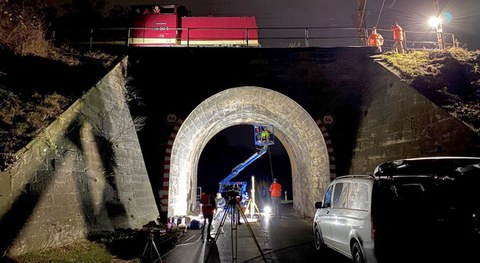Recalculation of arched bridges
Table of contents
Project data
| Titel | Title Nachrechnung von Gewölbebrücken | Recalculation of arched bridges Förederer | Funding |
Report from annual report 2023
Load-bearing behavior of railroad arch bridges

Load test of the arch bridge Schöninger Straße in Helmstedt
Bridges made of stone arches have been built for centuries, making them one of the oldest types of bridge construction. The comparatively high average age of arch bridges speaks for the durability of this type of construction. They still account for a large proportion of the bridges in the network of Deutsche Bahn today: around a quarter of DB’s 26,000 bridge structures are arch bridges. Although some of these structures still have a high residual load-bearing capacity, they are often replaced by reinforced concrete frame structures. The reason for this is usually poor condition due to external damage.
Even the structures were designed for much lower traffic loads, they can also meet the requirements of current and future traffic. This often requires constructive measures, such as increasing the safety space, and also static verifications of the load-bearing capacity. Due to the large number of structures, maximum preservation of the substance cannot be achieved with individual solutions for each structure. The aim of the research project is therefore to derive standardized recalculation concepts for railroad arch bridges so that the preservation of these structures can be simplified. This not only preserves building culture and reduces costs, but also contributes to climate protection.
The first step was to evaluate the existing building stock in order to identify the types of structure that occur particularly frequently. In the course of a geometric classification based on as-built plans, a strong dependence of the geometry of an arched bridge on the ratio of arch span to clear width was shown. On this basis, the structures can be divided into three clusters with associated geometric parameters. A validation based on occurring damage confirmed different damage mechanisms per cluster, which in turn indicate different load-bearing behavior.
In the next step, the load-bearing behavior of typical arch bridges will be analyzed. This involves complex finite element simulations, which can be calibrated with load tests on real structures.
